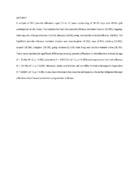| dc.description.abstract | A sample of 457 juvenile offenders aged 11 to 17 years comprising of 50.1% boys and 49.9% girls participated in the study. The adjudicated low-risk juvenile offences included truancy (12.9%), begging, loitering and child prostitution (16.1%), larceny (16.5%), drug and alcohol-related offences (18.0%). The high risk juvenile offences included murder and manslaughter (4.5%), rape (6.9%), robbery (16.8%), assault (20.8%), burglary (19.3%), gang violence (11.4%) and drug and alcohol-related crime (20.3%). There were statistically significant differences among juvenile offenders in rehabilitation schools by age (F = 22.44; df =1; p = 0.04), education (F = 3247.517; df =1; p = 0.000) and exposure to low-risk offences (F = 112.36; df =1; p = 0.000). However, males and females did not differ in their criminogenic disposition (F = 0.0007; df =1; p = 0.98). It was recommended that Juvenile delinquency should be mitigated through effective school-based prevention programmes in Kenya. | en_US |
